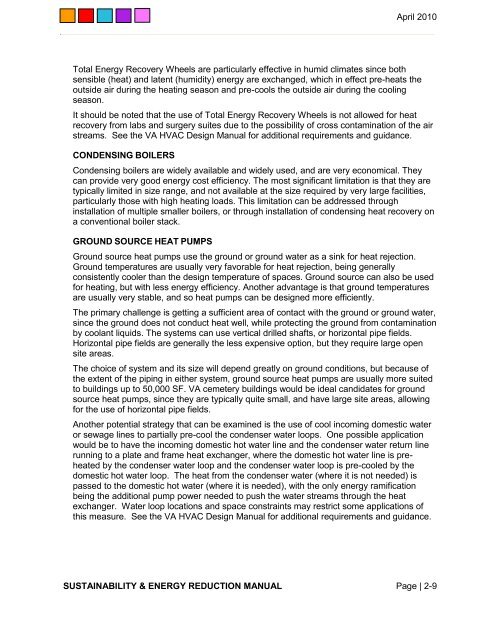Sustainability Design and Energy Reduction Manual - The Whole ...
Sustainability Design and Energy Reduction Manual - The Whole ...
Sustainability Design and Energy Reduction Manual - The Whole ...
Create successful ePaper yourself
Turn your PDF publications into a flip-book with our unique Google optimized e-Paper software.
April 2010<br />
Total <strong>Energy</strong> Recovery Wheels are particularly effective in humid climates since both<br />
sensible (heat) <strong>and</strong> latent (humidity) energy are exchanged, which in effect pre-heats the<br />
outside air during the heating season <strong>and</strong> pre-cools the outside air during the cooling<br />
season.<br />
It should be noted that the use of Total <strong>Energy</strong> Recovery Wheels is not allowed for heat<br />
recovery from labs <strong>and</strong> surgery suites due to the possibility of cross contamination of the air<br />
streams. See the VA HVAC <strong>Design</strong> <strong>Manual</strong> for additional requirements <strong>and</strong> guidance.<br />
CONDENSING BOILERS<br />
Condensing boilers are widely available <strong>and</strong> widely used, <strong>and</strong> are very economical. <strong>The</strong>y<br />
can provide very good energy cost efficiency. <strong>The</strong> most significant limitation is that they are<br />
typically limited in size range, <strong>and</strong> not available at the size required by very large facilities,<br />
particularly those with high heating loads. This limitation can be addressed through<br />
installation of multiple smaller boilers, or through installation of condensing heat recovery on<br />
a conventional boiler stack.<br />
GROUND SOURCE HEAT PUMPS<br />
Ground source heat pumps use the ground or ground water as a sink for heat rejection.<br />
Ground temperatures are usually very favorable for heat rejection, being generally<br />
consistently cooler than the design temperature of spaces. Ground source can also be used<br />
for heating, but with less energy efficiency. Another advantage is that ground temperatures<br />
are usually very stable, <strong>and</strong> so heat pumps can be designed more efficiently.<br />
<strong>The</strong> primary challenge is getting a sufficient area of contact with the ground or ground water,<br />
since the ground does not conduct heat well, while protecting the ground from contamination<br />
by coolant liquids. <strong>The</strong> systems can use vertical drilled shafts, or horizontal pipe fields.<br />
Horizontal pipe fields are generally the less expensive option, but they require large open<br />
site areas.<br />
<strong>The</strong> choice of system <strong>and</strong> its size will depend greatly on ground conditions, but because of<br />
the extent of the piping in either system, ground source heat pumps are usually more suited<br />
to buildings up to 50,000 SF. VA cemetery buildings would be ideal c<strong>and</strong>idates for ground<br />
source heat pumps, since they are typically quite small, <strong>and</strong> have large site areas, allowing<br />
for the use of horizontal pipe fields.<br />
Another potential strategy that can be examined is the use of cool incoming domestic water<br />
or sewage lines to partially pre-cool the condenser water loops. One possible application<br />
would be to have the incoming domestic hot water line <strong>and</strong> the condenser water return line<br />
running to a plate <strong>and</strong> frame heat exchanger, where the domestic hot water line is preheated<br />
by the condenser water loop <strong>and</strong> the condenser water loop is pre-cooled by the<br />
domestic hot water loop. <strong>The</strong> heat from the condenser water (where it is not needed) is<br />
passed to the domestic hot water (where it is needed), with the only energy ramification<br />
being the additional pump power needed to push the water streams through the heat<br />
exchanger. Water loop locations <strong>and</strong> space constraints may restrict some applications of<br />
this measure. See the VA HVAC <strong>Design</strong> <strong>Manual</strong> for additional requirements <strong>and</strong> guidance.<br />
SUSTAINABILITY & ENERGY REDUCTION MANUAL Page | 2-9

















